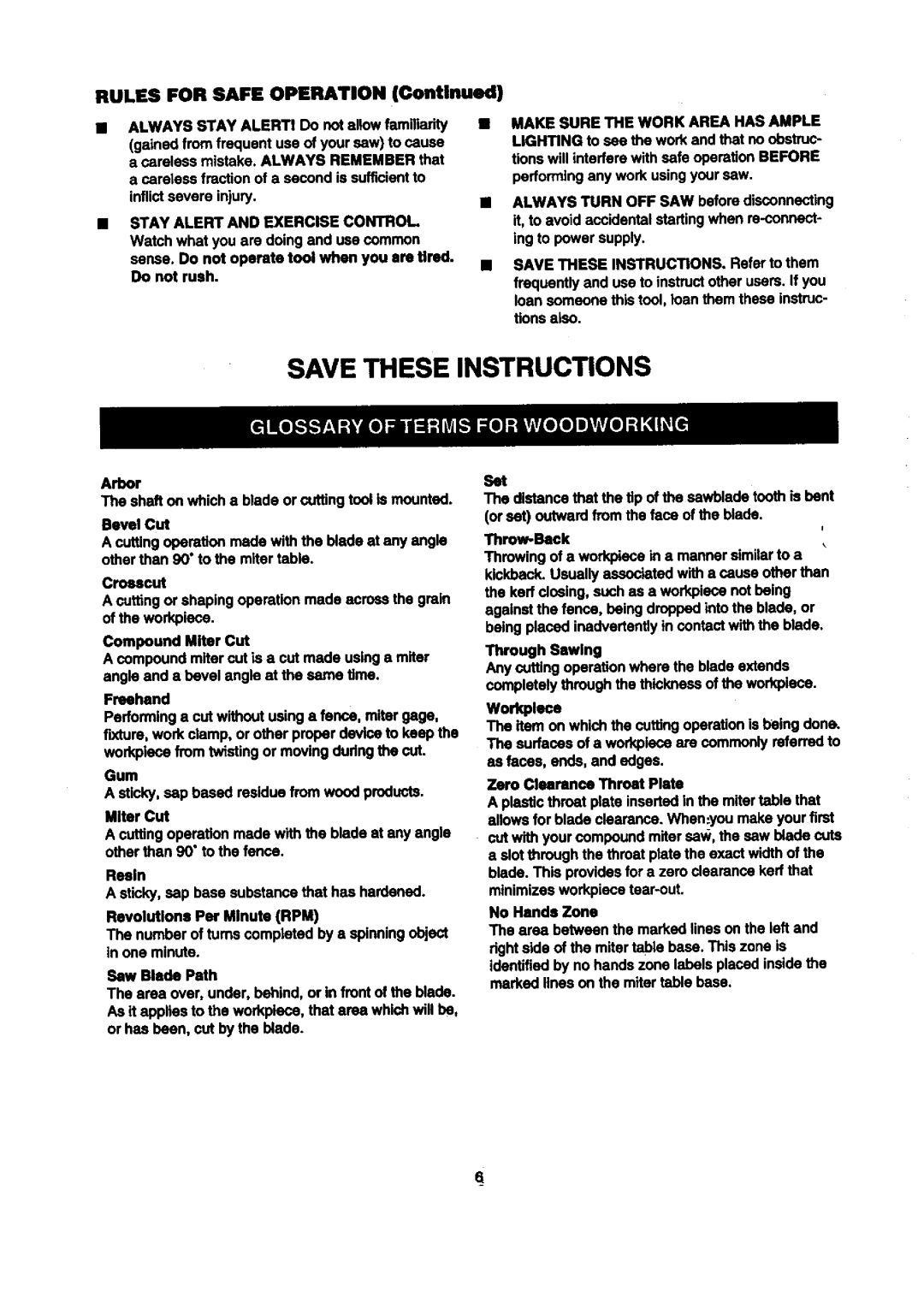
RULES FOR SAFE OPERATION (Continued)
• ALWAYS STAY ALERT! Do not allowfamiliarity •
(gained from frequent use of your saw) to cause a careless mistake. ALWAYS REMEMBER that a careless fraction of a second is sufficientto
inflictsevere injuPJ. | • |
ffi STAY ALERT AND EXERCISE CONTROL |
|
Watch what you are doing and use common |
|
sense. Do not operate tool when you are tired, | ffi |
Do not rush. |
|
MAKE SURE THE WORK AREA HAS AMPLE LIGHTING to see the work and that no obMtruc- tions will interfere with safe operation BEFORE performingany work using your saw.
ALWAYS TURN OFF SAW before disconnecting it, to avoid accidental startingwhen
SAVE THESE INSTRUCTIONS. Refer to them
frequently and use to instructother users. If you loan someone this tool, loan them these instruc-
Miens also.
SAVE THESE INSTRUCTIONS
Arbor
The shaft on which a blade or cuttingtool is mounted.
Bevel Cut
Acutting operation made with the blade at any angle other than 90" to the miter table,
Crosscut
A cuffing or shaping operation made across the grain of the workpiece.
Compound Miter Cut
Acompound miter cut is a cut made using a miter angle and a bevel angle at the same time.
Freehand
Performinga cut without using a fence, miter gage, fixture, work clamp, or other proper device to keep the workplece from twisting or moving dudng the cut.
Gum
Asticky, sap based residue from wood products, Mlter Cut
A cutting operation made with the blade at any angle other than 90" to the fence.
Resin
A sticky, sap base substancethat has hardened.
Revolutions Per Minute (RP•)
The number of turns completed by a spinningobject in one minute.
Saw Blade Path
The area over, under, behind, or in front of the blade. As it applies to the workplece, that area whichwill be, or has been, cut by the blade.
Set
The distance that the tip of the sawblede toothis bent (or set) outward from the face of the blade.
I
Throwing of a workplece in a manner similarto a kickback. Usually associatedwith a cause other than the kerf dosing, such as a workpisce not being against the fence, being dropped intothe blade, or being placed inadvertentlyin contact with the blade.
Through Sawing
Any cutting operation where the blade extends completely through the thicknessof the workplace.
Workplece
The item on whichthe cuffingoperation is being done. The surfaces of a workpleca are commonly referred to as faces, ends, and edges.
Zero Clearance Throat Plate
A plasticthroat plate inserted In the mitertable that allows for blade clearance. When:you make your first
cut with your compound miter sew, the sew blade cuts
aslot through the throat plate the exact width of the blade. This providesfor a zero clearance kerf that
minimizesworkpisca
No Hands Zone
The area between the marked lines on the left and dght side of the miter table base. This zone is identified by no hands zone labels placed inside the marked lines on the miter table base.
